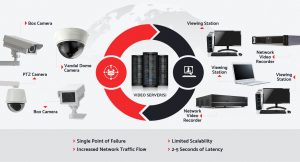IT Professional
The foundation of a successful municipal wide IP surveillance system is the design and deployment of the network infrastructure. Assuming no single-point of failure, which is inherent in peer-to-peer architecture, the results will produce a system with high uptime and availability, minimal latency, scalability, and resource sharing.
Security Detect employs the highest security standard, ensuring that video data can transport and be accessed using the latest security protocols, utilizing hardened passwords along with restricted physical and network access
Reliability The reliability of the peer-to-peer Detect Surveillance solution offers significant uptime compared to traditional client-server solutions.
Unification Municipal surveillance is often comprised of isolated efforts to cover key areas. DETECT can often combine disparate surveillance systems to maximize previous investments, unified in a common user interface.
Scalability From the scalable peer-to-peer architecture to configuration management software tools and experience, we can expand the capabilities of your municipal surveillance system while maintaining its mission essential status.
Standards Based DETECT runs on a standards-based Windows software platform designed to operate on Leverage’s Patented Peer-to-Peer Surveillance Architecture. The features and functionality of DETECT VMS specifically address municipal surveillance requirements.
Support Maintenance and support are critical to the long-term success of any surveillance network, especially those which are critical to public safety initiatives. When something does come up, we are able to quickly assess and resolve it with our remote and onsite support capabilities.
New Technologies Foundationally, the Detect P2P solution presents an innovative path to implement new technologies, such as Artificial Intelligence (AI) algorithms, which help identify persons and property for quick notifications.
What are the unique aspects of Video Surveillance networks?
Unlike traditional data networks, surveillance video networks support consistent data transmission with a fluctuating load yet still have an expectation of high availability and reliability.
 While edge recording may solve the problem of recording interruption due to network anomaly – this offers no solution to the availability of real-time live video. Detect System Monitoring and Reporting Technology equips VSS operators and administrators with a powerful tool to ensure optimal system performance and availability. The Detect SMART service not only keeps system administrators and users appraised of regular system performance data, but it provides insight into problems that may be looming on the horizon. Historical performance logging creates priceless empirical data that illustrates how surveillance assets are actually performing within the surveillance environment. Of course, OEMs provide predictive tools (design tools, calculators, storage estimators, etc.) but the information provided by these tools is generic in nature and only to be used in “estimation” of performance. SMART’s empirical reporting system provides accurate, actual environment tested data that can immediately provide administrators with predictive information regarding the accuracy of system design and expectation. Most importantly, SMART enables VSS integrators and administrators to remedy system vulnerabilities before they become system failures!
While edge recording may solve the problem of recording interruption due to network anomaly – this offers no solution to the availability of real-time live video. Detect System Monitoring and Reporting Technology equips VSS operators and administrators with a powerful tool to ensure optimal system performance and availability. The Detect SMART service not only keeps system administrators and users appraised of regular system performance data, but it provides insight into problems that may be looming on the horizon. Historical performance logging creates priceless empirical data that illustrates how surveillance assets are actually performing within the surveillance environment. Of course, OEMs provide predictive tools (design tools, calculators, storage estimators, etc.) but the information provided by these tools is generic in nature and only to be used in “estimation” of performance. SMART’s empirical reporting system provides accurate, actual environment tested data that can immediately provide administrators with predictive information regarding the accuracy of system design and expectation. Most importantly, SMART enables VSS integrators and administrators to remedy system vulnerabilities before they become system failures!


